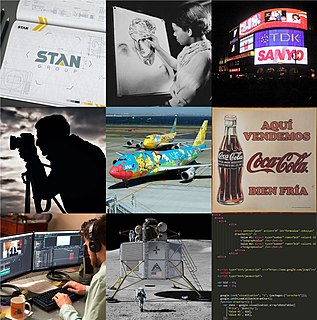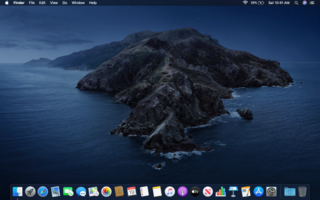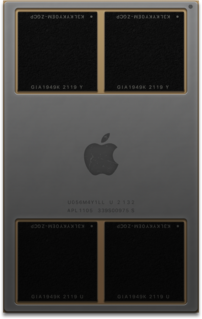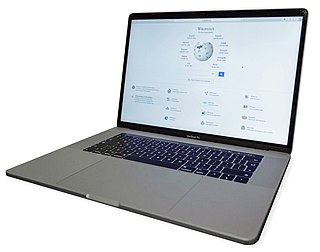
Graphic design is the profession and academic discipline whose activity consists in projecting visual communications intended to transmit specific messages to social groups, with specific objectives. Design is based on the principle of "form follows a specific function".
Desktop publishing (DTP) is the creation of documents using page layout software on a personal ("desktop") computer. It was first used almost exclusively for print publications, but now it also assists in the creation of various forms of online content. Desktop publishing software can generate layouts and produce typographic-quality text and images comparable to traditional typography and printing. Desktop publishing is also the main reference for digital typography. This technology allows individuals, businesses, and other organizations to self-publish a wide variety of content, from menus to magazines to books, without the expense of commercial printing.

Susan Kare is an American artist and graphic designer best known for her interface elements and typeface contributions to the first Apple Macintosh from 1983 to 1986. She was employee #10 and Creative Director at NeXT, the company formed by Steve Jobs after he left Apple in 1985. She was a design consultant for Microsoft, IBM, Sony Pictures, and Facebook, Pinterest and she is now an employee of Niantic Labs. As an early pioneer of pixel art and of the graphical computer interface, she has been celebrated as one of the most significant technologists of the modern world.
A number of vector graphics editors exist for various platforms. Potential users of these editors will make a comparison of vector graphics editors based on factors such as the availability for the user's platform, the software license, the feature set, the merits of the user interface (UI) and the focus of the program. Some programs are more suitable for artistic work while others are better for technical drawings. Another important factor is the application's support of various vector and bitmap image formats for import and export.

Scott Kelby is an American photographer and an author and publisher of periodicals dealing with photography and Adobe Photoshop software, for design professionals, photographers, and artists.

An error message is information displayed when an unforeseen problem occurs, usually on a computer or other device. On modern operating systems with graphical user interfaces, error messages are often displayed using dialog boxes. Error messages are used when user intervention is required, to indicate that a desired operation has failed, or to relay important warnings. Error messages are seen widely throughout computing, and are part of every operating system or computer hardware device. Proper design of error messages is an important topic in usability and other fields of human–computer interaction.

The MacBook Pro is a line of Macintosh notebook computers by by Apple Inc. Introduced in January 2006, it is the higher-end model of the MacBook family, sitting above the consumer-focused MacBook Air. It is currently sold with 13-inch, 14-inch, and 16-inch screens, all using variants of the Apple-designed M1 system on a chip.

The MacBook is a line of Macintosh notebook computers designed, manufactured and sold by Apple Inc. from May 2006 to February 2012. A new line of computers by the same name was released in 2015, serving the same purpose as an entry-level laptop. It replaced the iBook series of notebooks as a part of Apple's transition from PowerPC to Intel processors. Positioned as the low end of the MacBook family, below the premium ultra-portable MacBook Air and the powerful MacBook Pro, the MacBook was aimed at the consumer and education markets. It was the best-selling Macintosh ever. For five months in 2008, it was the best-selling laptop of any brand in US retail stores. Collectively, the MacBook brand is the "world's top-selling line of premium laptops."

Mac Pro is a series of workstations and servers for professionals that are designed, developed and marketed by Apple Inc. since 2006.

The Intel-based iMac is a discontinued series of Macintosh desktop computers designed, manufactured and sold by Apple Inc. from 2006 to 2022. While sold, it was one of three desktop computers in the Macintosh lineup, serving as an all-in-one alternative to the Mac Mini, and sat below the performance range Mac Pro. It was sold alongside the Xeon-based iMac Pro from 2017 to 2021.
Peachpit is a publisher of books focused on graphic design, web design, and development. Peachpit's parent company is Pearson Education, which owns additional educational media brands including Addison-Wesley, Prentice Hall, and New Riders.

Xgrid is a proprietary program and distributed computing protocol developed by the Advanced Computation Group subdivision of Apple Inc that allows networked computers to contribute to a single task.

The Macintosh is a family of personal computers designed, manufactured, and sold by Apple Inc. since January 1984.

iMac is a family of all-in-one Macintosh desktop computers designed and built by Apple Inc. It has been the primary part of Apple's consumer desktop offerings since its debut in August 1998, and has evolved through seven distinct forms.

AirDrop is a proprietary ad hoc service in Apple Inc.'s iOS and macOS operating systems, introduced in Mac OS X Lion and iOS 7, which can transfer files among supported Macintosh computers and iOS devices by means of close-range wireless communication. This communication takes place over Apple Wireless Direct Link 'Action Frames' and 'Data Frames' using generated link-local IPv6 addresses instead of the Wi-Fi chip's fixed MAC address.

macOS Catalina is the sixteenth major release of macOS, Apple Inc.'s desktop operating system for Macintosh computers. It is the successor to macOS Mojave and was announced at WWDC 2019 on June 3, 2019 and released to the public on October 7, 2019. Catalina is the first version of macOS to support only 64-bit applications and the first to include Activation Lock. It is also the last version of macOS to have the major version number of 10; its successor, Big Sur, released on November 12, 2020, is version 11. In order to increase web compatibility, Safari, Chromium and Firefox have frozen the OS in the user agent running in subsequent releases of macOS at 10.15.7 Catalina.

The Mac transition to Apple silicon is the process of changing the central processing units (CPUs) of Apple Inc.'s line of Mac computers from Intel's x86-64 processors to Apple-designed systems on a chip that use the ARM64 architecture. CEO Tim Cook announced a "two-year transition plan" in his WWDC keynote address on June 22, 2020, and the first Macs with Apple-designed systems on a chip were released that November.

The Apple M1 is an ARM-based system on a chip (SoC) designed by Apple Inc. as a central processing unit (CPU) and graphics processing unit (GPU) for its Macintosh desktops, MacBook notebooks, iPad Pro and iPad Air tablets. The new chip also brought Apple's third change to the instruction set architecture used by Macintosh computers, 14 years after they were switched from PowerPC to Intel. Apple said that the chip has the world's fastest CPU core "in low power silicon" and the world's best CPU performance per watt.

The Apple M1 Pro and M1 Max are systems-on-chip (SoC) designed by Apple Inc. for the MacBook Pro laptop and the lower-end Mac Studio desktop, based on the licensed ARM architecture, and manufactured on TSMC's N5 process. They were announced at an Apple event on October 18, 2021.

The Intel-based MacBook Pro is a discontinued line of Macintosh notebook computers sold by Apple Inc. from 2006 to 2021. It was the higher-end model of the MacBook family, sitting above the consumer-focused MacBook Air, and was sold with 13-inch to 17-inch screens.
















